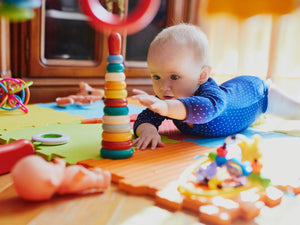Key Takeaways
- Engorgement can cause discomfort in the early days of breastfeeding; hand expressing for comfort, using cold packs, and frequent feeding can help.
- Babies who won’t latch initially may benefit from skin-to-skin contact, hand-expressed colostrum via syringe, and patience as they develop their feeding instincts.
- Shallow latching can lead to cracked nipples and blocked ducts, so seeking hands-on help to improve attachment and drainage is essential for healing.
- Conditions like thrush and tongue-tie require professional intervention, such as medication or a minor procedure, to resolve and support successful breastfeeding.
Breastfeeding isn’t always easy, so if you encounter a hiccup, it’s always best to ask for help early, to avoid things spiraling out of control. In a recent Australian Breastfeeding Association poll, more than 90% of breastfeeding mothers sought professional help with breastfeeding in their baby’s first 6 months, so if you need some guidance, remember you’re not alone. Here are some of the most common breastfeeding problems and suggestions to help alleviate them.
Common Breastfeeding Problems
Engorgement
When your milk first comes in, your breasts can really become tight and hard, and often feel quite sore and bruised. While this engorgement calms down after the first week, breasts can continue to feel uncomfortably full, especially if bubs goes a bit longer between feeds.
Some mums are tempted to whack on a breast pump, but this will only create more milk, so I suggest hand expressing for comfort only, and use cold gel packs (or refrigerated cabbage leaves) between feeds to reduce inflammation. And feed, feed, feed!

Baby won’t latch
In the early days, some babies aren’t very interested in feeding, and don’t latch on right away. The important thing is not to panic. Your baby’s tummy only starts off the size of a small marble, so he really doesn’t need much in the first few days.
Rather than jumping straight into formula and bottles, which can exacerbate the problem, spend lots of time skin-on-skin with your baby and consider hand expressing your colostrum (your midwife will show you how) and feeding this to bub every three or so hours via a syringe.
Sometimes drugs in labour can make them sleepy or there’s been some other birth trauma, so they may take a few days to wake up and properly tap into their instincts. Continue engaging with your baby to develop a correct latch.
Cracked or grazed nipples
If your baby’s attachment is too shallow, your nipple will rub against the hard palate of your baby’s mouth, causing friction and may result in damage such as grazes and cracks. Rather than slathering your nipples in various creams and hoping your nipples will toughen up, work on correcting the attachment pronto.
When the baby is deeply attached, the nipple goes back into the soft palate, where feeding doesn’t pinch or hurt, even if there is already damage. There’s only so much a diagram can help you with, so seek some hands-on help so you can learn how to encourage your baby open his mouth wider and some positioning techniques so you can bring your baby to the breast in a quick motion.
You can read more about how to care for your nipples whilst breastfeeding.

Blocked ducts and mastitis
When a baby isn’t latching well, there’re often not draining all the ducts around the nipple properly, which can result in blocked ducts. These can present as red patches on the breast accompanied by painful lumps, and if not treated, can turn into mastitis, a breast infection accompanied by flu-like symptoms.
Another cause is baby not feeding frequently enough. To treat, apply hot packs before feeds, massage the lumps towards the nipple while feeding, and apply cold packs after feeds to soothe the hotness. If you have mastitis, the treatment is the same, but visit your GP for antibiotics to knock out the infection.
Thrush
If you’ve had nipple cracks, bacteria can get in and breed thrush in your nipples or breast. It’s felt as a stabbing pain deep within the breast and isn’t just felt on attachment, it’s usually between feeds as well.
Again, visit a breastfeeding friendly-doctor, who will usually prescribe thrush tablets (as topical creams aren’t often strong enough to knock out this bacteria) and a gel to apply to your baby’s mouth. Without treating both, it can pass back and forth from baby to mother.
Tongue-tie
About 10% of babies are born with a tongue-tie, which is a condition where the frenulum (the piece of skin under the tongue) is too tight and the tongue cannot get adequate suction on the breast.
Babies with an undiagnosed tie usually do a lot of damage to their mum’s nipples and can struggle to gain weight. It’s a hereditary condition but the tie can be released by a doctor with a quick snip and breastfeeding can resume normally.
Our Products
-

01. Guide to a Healthy Pregnancy
$55 -

02. Positive Birthing Course
$55 -

03. Infant Feeding Guide
$55 -

04. Baby Sleep Guide - First 12 Months
$55 -

05. Toddler Parenting Course 1 - 3 Years
$55
-
 When to Start Antenatal Classes?
When to Start Antenatal Classes?
Becoming a parent is an incredible milestone, but it comes with a host of changes that can be daunting, especially for first time parents. Antenatal classes are all about offering expectant parents the education they need to make informed decisions, look after their bodies and care for their newborn babies. While you probably already have a long list of things you need to accomplish during your pregnancy, it’s a good idea to make time to attend antenatal classes.
-
 Development Milestones 4-8 Months
Development Milestones 4-8 Months
As they reach the middle of their first year, you'll start to see bigger leaps in their growth and ability!
In this article, we’re going to discuss your baby’s developmental milestones between 4-8 months, and what you can expect along the way.





 When to Start Antenatal Classes?
When to Start Antenatal Classes?
 Development Milestones 4-8 Months
Development Milestones 4-8 Months








